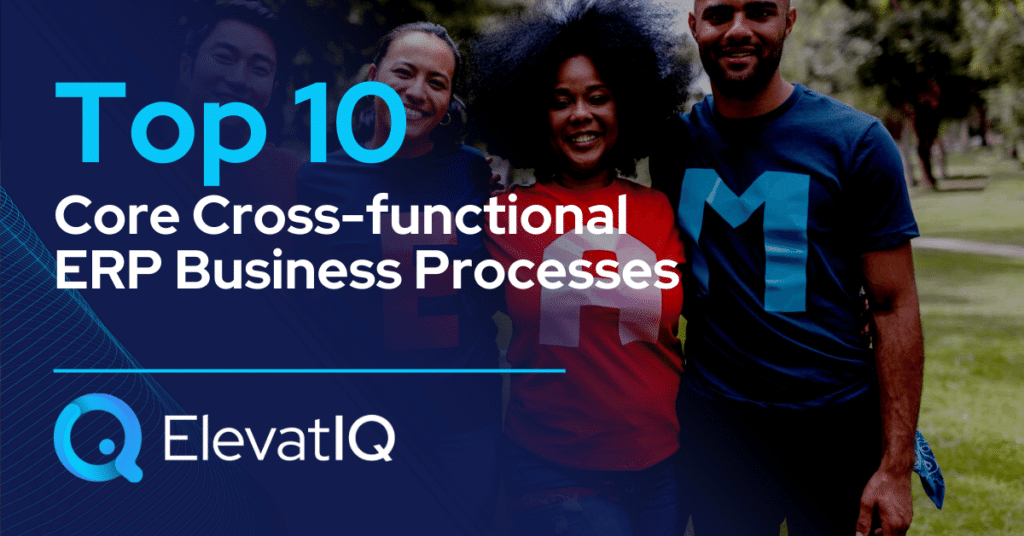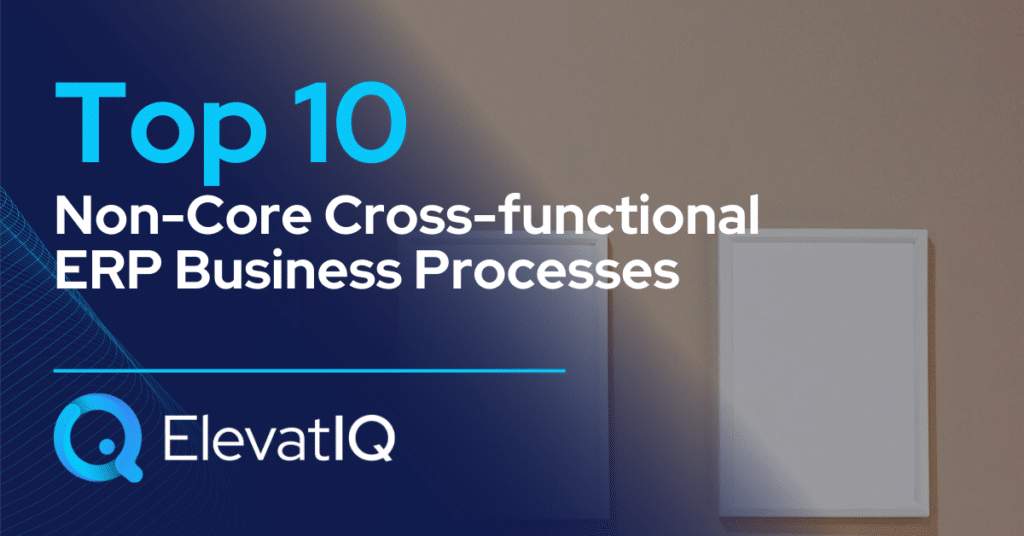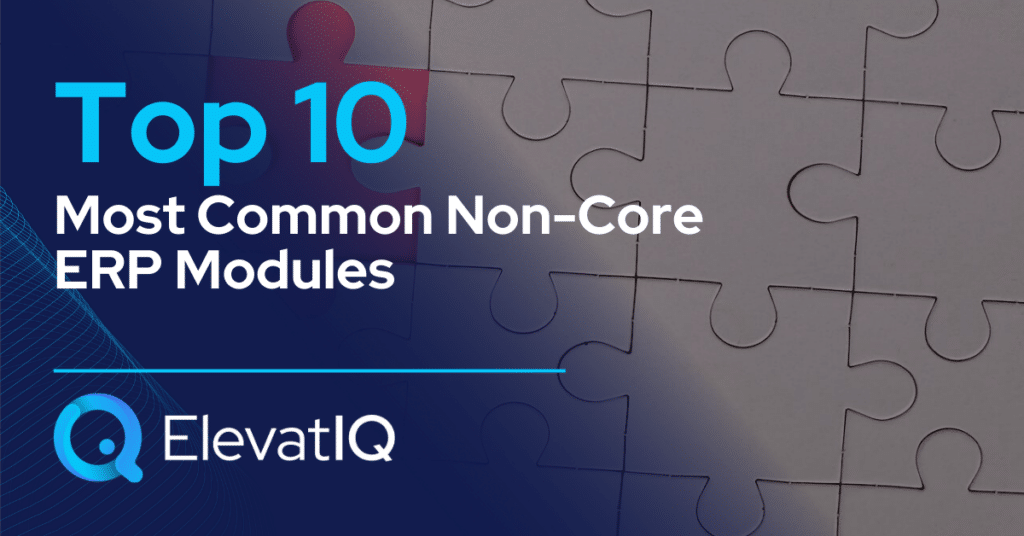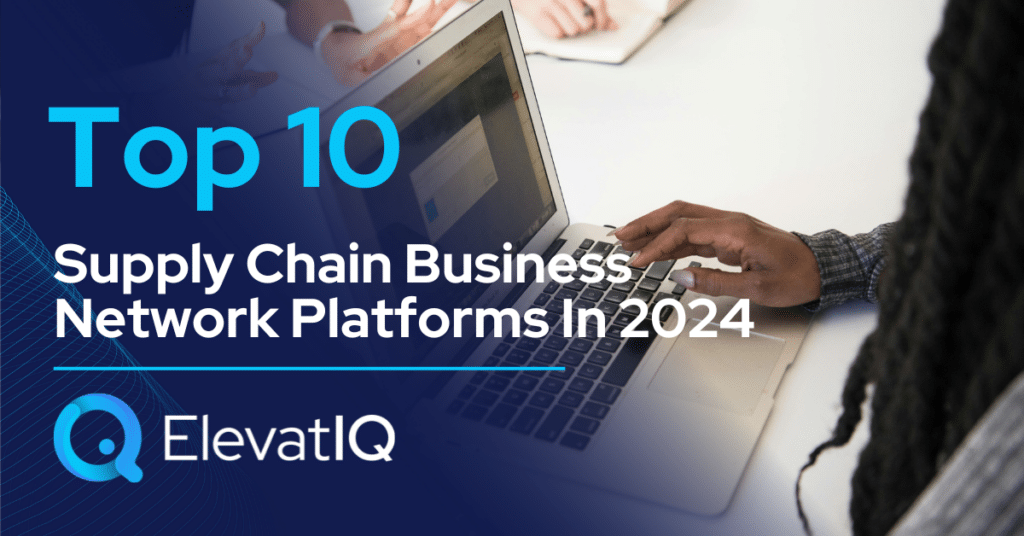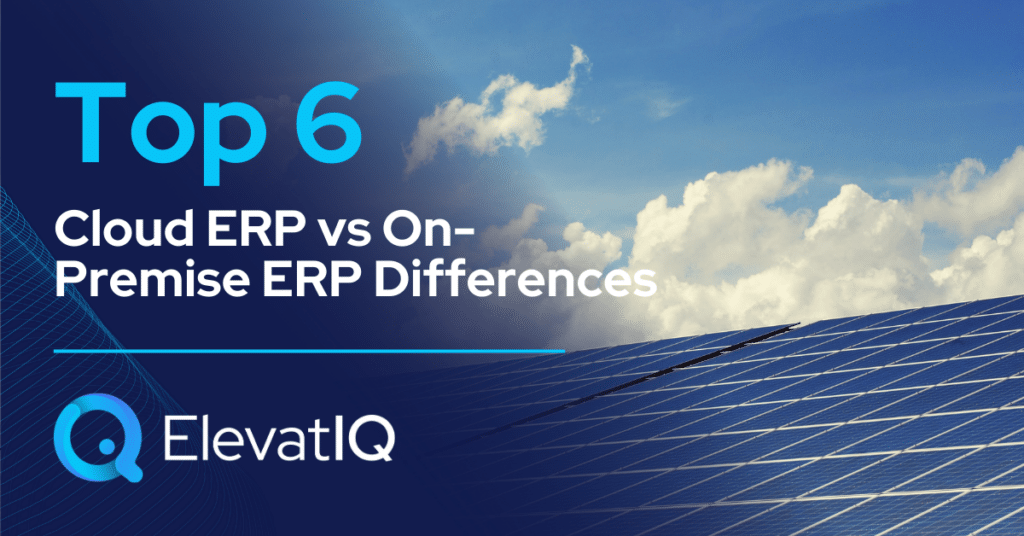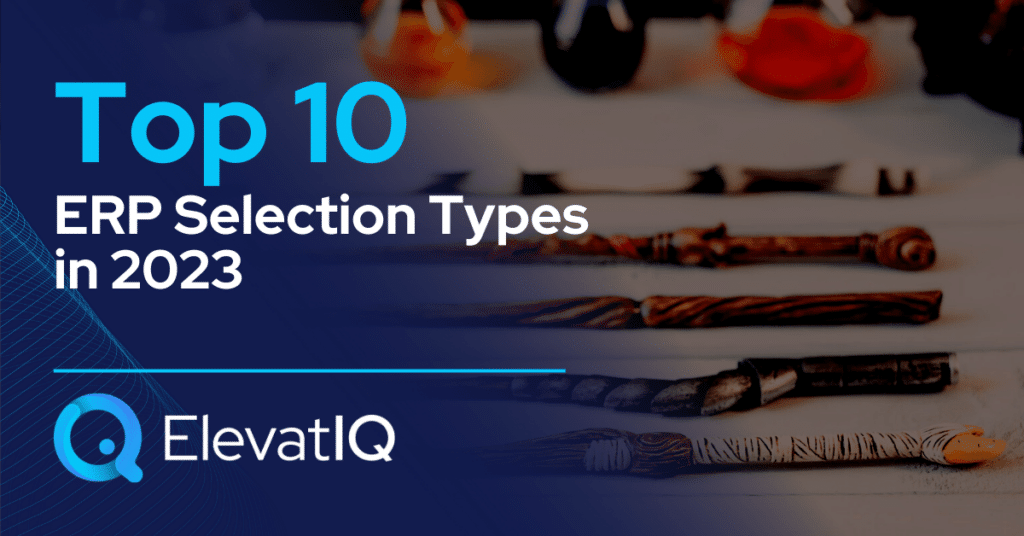ERP systems play an important role in streamlining the operations of a business. At the heart of these systems lie the core cross-functional business processes. Also, catering to the needs of different departments, these business processes are like building blocks for the organization to work smoothly. They include sequential activities across different departments to complete a financial or operational workflow. However, unlike ERP modules that you can choose individually, these core tightly integrated business processes rely on each other. In other words, implementing one process also entails addressing its underlying dependencies on other ERP business processes and modules.

Yet, the challenge many businesses face is understanding the significance of these core ERP processes. Without this essential knowledge, companies often encounter operational roadblocks and inefficiencies. Departments might function in isolation, lacking the interconnectedness needed for streamlined operations. This is why understanding these core cross-functional business processes is very important.
In this blog, we will talk about the top 10 core cross-functional business processes that bind different departments together.

1. Order-to-cash
The order-to-cash process is a complex business operation that includes various departments within an organization, such as sales, operations, and finance. From its initiation to the collection of payment, this process involves the entire lifecycle of a customer order. When a customer places an order, the process begins. Sales teams are responsible for capturing the order details, including product or service specifications, quantity, pricing, and customer information.
Upon capturing an order and validating it, it moves to the operations department for processing. Operations personnel check inventory levels, product availability, and service delivery schedules if applicable. To fulfill the customer’s requirements, they also create picking lists, work orders, or service orders. This step in some industries, such as manufacturing or service-based businesses, ensures that the products or services meet the order specifications. After order fulfillment, the finance department generates an invoice based on the order details. Upon issuing the invoice, the finance team tracks and manages payments from the customer.
Depending on the organization’s architectural boundaries, some companies host this process on one or multiple. Sometimes, the boundary of an ERP system may start from an invoice or GL. In other cases, the whole process happens within the ERP system. Therefore, when you choose an ERP system, define how much order-to-cash you would host inside the ERP. This will also help you find the right ERP system aligned with your business needs.
2. Procure-to-pay
Managed within an ERP system, the procure-to-pay process is among significant cross-functional ERP business processes. Generally, this process encompasses several stages and involves different departments within an organization, including procurement, warehouse management, finance, and accounting. The process begins with the procurement department capturing a purchase order.
Upon capturing the purchase order, the warehouse receives the inventory. After this, the finance department receives the vendor’s invoice, which includes the billing details for the delivered goods or services. Then, they would match an invoice against the corresponding purchase order and receipt information in the ERP system to ensure accuracy. The finance department initiates the payment process after the invoice is verified and approved.
The degree of integration with the P2P process into a single ERP system can vary among organizations. Some may handle the entire process within the ERP, starting from the purchase order, while others might use additional specialized systems for certain steps, like procurement software for purchase order management.
3. Plan-to-produce/Plan-to-inventory
The plan-to-produce/plan-to-inventory business process is particularly relevant for industries that require accurate forecasting and planning of inventory before production. Commonly seen in consumer-centric and commoditized industries, the process begins with S&OP analyzing historical sales data, market trends, customer demand, and other relevant factors to forecast the demand for their products.
After forecasting demand, the next step is supply planning. In this phase, companies determine how they will meet the anticipated demand. It involves assessing the available resources, production capacity, and procurement capabilities. Once the supply plan is in place, the procurement department comes into play. Their role is to source the necessary materials, components, and resources required for production. This might involve negotiating with suppliers, placing orders, and managing the procurement process efficiently to ensure that materials are available when needed for production. With the materials procured and the supply plan in hand, the production and manufacturing teams swing into action. To produce the goods in line with the forecasted demand, they use the production schedule generated during supply planning.
Some companies might host the entire P2P process within their ERP system. In such cases, the ERP system handles everything from forecasting and planning to procurement and inventory management. However, others may use a separate S&OP system for initial demand forecasting and supply planning. In the latter case, the S&OP system feeds planned forecasts and supply plans into the ERP system to execute the production and inventory management processes.
4. Record-to-report
Primarily managed by the finance department within an organization, the record-to-report process is a critical business process. Its main purpose is to handle non-operational transactions accurately. In many organizations, ERP systems play a central role in managing financial data. However, ERPs may not offer automated recording of all financial transactions as some are non-operational and might require manual recording. The process begins with the finance department recording financial transactions.
After recording transactions, finance professionals reconcile accounts. This step is crucial for ensuring that the recorded data is accurate and that there are no discrepancies or errors. Reconciliation involves comparing various financial records and ensuring they match. While the core of the record-to-report process resides within the finance department, it might require multiple systems to manage it. For example, they might use the ERP system to capture and initial transaction reconciliation. Still, they may transfer GL data to a separate FP&A software system. Before generating final financial reports, finance teams might sometimes consolidate data in the FP&A software. This step is essential for producing accurate reports, especially for larger organizations with multiple subsidiaries or divisions.
The ultimate goal of the record-to-report process is to create financial reports. These reports provide a snapshot of an organization’s financial health and performance over a specific period, such as a month, quarter, or year. Before finalizing and distributing financial reports, finance professionals often analyze the data to identify trends, anomalies, and insights. The record-to-report process also plays a significant role in ensuring compliance with financial regulations and standards. Organizations may be subject to internal and external audits to verify the accuracy and legality of their financial statements.
5. Source-to-pay
The source-to-pay business process is one of the workflows within an ERP system that encompasses activities related to sourcing and procurement. Organizations follow a series of steps to effectively manage their procurement cycle, from identifying and building consensus on the need to identifying qualified vendors and finalizing payments. The process usually starts with identifying the organization’s need for certain goods or services.
Post that, it often requires consensus-building within the organization among various stakeholders. This step ensures the procurement aligns with the organization’s goals and budgets. After obtaining internal consensus, the next step is to identify potential vendors or suppliers who can fulfill the requirements. Upon identifying potential vendors, the organization conducts a thorough vetting process to assess their capabilities, financial stability, and adherence to legal and ethical standards. This step helps in ensuring that selected vendors are trustworthy and capable. After vetting the vendors, the organization awards a contract to the selected vendor(s). This contract outlines the terms and conditions of the procurement, including pricing, delivery schedules, and quality standards. This step formalizes the relationship between the organization and the vendor.
With the contract in place, the process proceeds with all the steps of the P2P process. Depending on the complexity of the sourcing phase, there might be several systems, and the ERP flow might start with a purchase order. The other companies might host RFQ comparisons, etc., inside the ERP.

6. Idea-to-Offering
The idea-to-offering business process is essential to new product development within a company. This process involves multiple stages and activities, from marketing to operations, figuring out go-to-market fit before a product is ready for production. The process starts with extensive market research and analysis to understand the potential demand for the product. This includes studying customer needs, preferences, and market trends to refine the concept and make it more customer-centric.
After gaining insights from customer research, the company begins the engineering phase. This involves designing and developing prototypes or mock-ups of the product to test its feasibility and functionality. In parallel with engineering, the company starts the procurement process. This involves sourcing the necessary materials, components, and resources for the product. Procurement also includes negotiations with suppliers for pricing and terms. The company works closely with its suppliers and partners during the design and sampling phase to ensure efficient manufacturing of products and meet quality standards. Simultaneously, the operations team strategizes the go-to-market plan. This involves deciding on pricing, distribution channels, marketing campaigns, and other factors essential for successfully launching the product.
At this point, some companies may host this process in different systems. For instance, They might use a PLM system for program and idea management, CAD/PDM tools for engineering, and P2P systems for vendor collaboration. When all preparations are in place, the ERP system takes over. With the product now in the ERP system, production can begin. Some companies may host the entire idea-to-offering process within their ERP system, consolidating all stages and data into a single integrated platform for more streamlined management and control.

7. Count-to-reconcile
The count-to-reconcile among ERP business processes is an integral part of managing inventory within an ERP system if it is the main source of truth for inventory. It’s a systematic procedure that usually begins with the planning phase for inventory reconciliation. This involves deciding how often inventory counts will occur (e.g., daily, weekly, monthly) and which inventory items, warehouses, or locations will be included in the counting process. To prioritize inventory counting efforts, items are often categorized into different classes based on their value, criticality, or other relevant factors. The ABC classification system typically consists of: A-Class: High-value or critical items, B-Class: Moderately valuable items, and C-Class: Low-value or less critical items.
Once the items are categorized, specific items, warehouses, or locations are identified for counting based on the inventory reconciliation plan. A pick list is generated to guide the counting process. Depending on the organization’s technology and preferences, the counting can be done using handheld devices. Discrepancies between the physical count and the ERP records are inevitable. If found, adjustments are made. Once all items have been counted, adjustments are posted. It reconciles any discrepancies identified during the counting process.
Depending on the organization’s technology landscape, inventory and location information might be stored in various systems like WMS, eCommerce platforms, or OMS. In many cases, the ERP system is the central source of truth for inventory management. This means that all inventory-related information and adjustments are primarily handled within the ERP. Therefore, the Count-to-Reconcile process plays a critical role in maintaining the accuracy of inventory data within the ERP system.
8. Forecast-to-monitor
The forecast-to-monitor business process plays a significant role in the budgeting and financial management of an organization. It involves a series of steps designed to ensure that an organization effectively plans, tracks, and manages the budget of each account and department. The process begins with planning various financial scenarios.
Once done, historical trends for each account are analyzed to create accurate budgets. This involves looking at past financial data, such as revenue growth, cost patterns, and other relevant financial metrics. The key aspect of this business process is collaboration. Teams from various departments within the organization need to work together to develop a comprehensive budget. Each department will have its budgetary requirements and contributions to the overall budget. Collaboration ensures that all stakeholders’ input is considered in the budgeting process. After considering different scenarios, analyzing historical trends, and collaborating with teams, the organization sets its budget for the upcoming year. Once the budget is set, it’s crucial to monitor and manage it throughout the year continuously.
Depending on the complexity of the budgeting process and the data requirements, organizations may choose to manage this process within their FP&A department or directly inside their ERP system. If they opt to use the ERP, it typically involves entering budgeted numbers into the ERP system to track yearly performance.
9. Inspect-to-comply
The inspect-to-comply business process is part of the quality management process. The workflow usually begins with the creation of a detailed test plan. This plan outlines the specific quality criteria and standards that need to be met for the product or material being tested. It specifies what aspects will be inspected, which tests will be conducted, and the testing methods to be used.
Once the plan is in place, the next step is to identify the test cases. Test cases are specific scenarios or conditions that are designed to evaluate the quality of the product or material. These test cases are based on the requirements outlined in the test plan. After identifying the test cases, the next step involves identifying and selecting inventory items that need to go through the quality inspection process. Once the inventory items are identified, the next step is to execute the test steps according to the predefined test cases. During the execution of test steps, all relevant data and test results are recorded and documented. In some cases, materials may not meet the quality standards initially. When this happens, a material review process is initiated.
Finally, the process involves preparing all necessary documentation to ensure compliance with quality standards and regulations. This documentation may include test reports, certificates of compliance, and other records that demonstrate that the items have met the required quality criteria. Depending on the organization’s setup, the quality management processes can be integrated into their ERP system, typically in a dedicated quality module. Alternatively, some organizations may use external quality management software that works in conjunction with their ERP system to handle these ERP business processes efficiently.
10. Cradle-to-grave/Acquire-to-retire
The cradle-to-grave/acquire-to-retire process is a significant approach to managing an organization’s entire lifecycle of assets. This process includes several stages, from the initial acquisition of assets to their eventual retirement. It usually begins with the acquisition of new assets within an organization. During acquisition, the organization typically creates purchase orders, negotiates contracts, and records the financial transactions related to the asset procurement.
After acquisition, the assets are integrated into the organization’s financial system, often within an ERP system. The financial process among ERP business processes includes recording the asset’s value, computing the depreciation lifecycle, and accounting for related expenses such as maintenance, insurance, or licensing fees. This often leads to the steps of generating reports and retirement of assets. Reporting is crucial to monitor asset performance, maintenance costs, and compliance with accounting standards. As assets reach the end of their useful life or become obsolete, they are retired from active use.
Depending on the organization’s industry and the complexity of asset management, the entire process may be handled within a single ERP system. Alternatively, some companies may use a combination of systems, with the ERP managing financial aspects and Enterprise Asset Management (EAM) or Manufacturing Execution Systems (MES) handling maintenance and operational aspects.

Conclusion
To summarize, the top 10 core cross-functional ERP business processes are essential components that help organizations operate efficiently. These processes connect different departments of a company and are vital for various tasks, from managing customer orders to handling procurement, forecasting demand, maintaining financial records, sourcing, and developing new products.
Understanding and improving these ERP business processes is not optional; it’s perhaps the first step for organizational integration and finding synergies across departments. These processes align departments in how they will be processing transactions and what will be their roles and responsibilities in facilitating that. Whether fully integrated into ERP systems or supported by other software, these processes are fundamental to improving efficiency and effectiveness in diverse industries.


